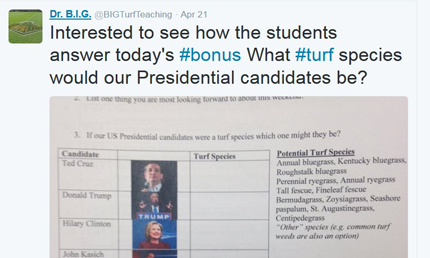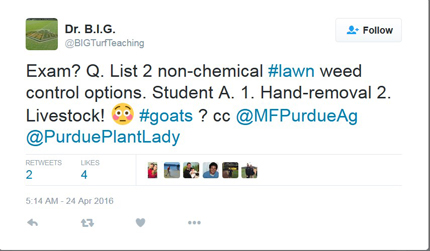5585 Guilford Road • Madison, WI 53711-5801 • 608-273-8080 • Fax 608-273-2021
www.agronomy.org
Twitter | Facebook
NEWS RELEASE
Contact: Hanna Jeske, Associate Director of Marketing and Brand Strategy, 608-268-3972, hjeske@sciencesocieties.org
Hashtags, turf, and classrooms
Aug. 10, 2016 - Here’s a new way to communicate with today’s college students: “Tomorrow we begin #turf fertility for my ‘Lawns 101 class’…What are the three most important take-aways related to feeding lawns? #discuss”.
 Is this the #futureofeducation? All hashtags aside, for Cale Bigelow, a professor at Purdue University’s Turf Science program, the future – and present – includes social media.
Is this the #futureofeducation? All hashtags aside, for Cale Bigelow, a professor at Purdue University’s Turf Science program, the future – and present – includes social media.
Bigelow’s interest is more than a passing Snapchat. In 2011 and 2012, he and colleague John Kaminski (from The Pennsylvania State University) surveyed turf students about their social media use and attitudes. Although their motivation was to increase student engagement, their findings and experience provided a broader reach.
The concept of student engagement is key for Bigelow. “It’s all about engagement—how can you inspire, stimulate, get them to ask a question, and want to learn more. There’s an aspect of enthusiasm. They’re paying attention, mentally chewing on something. They’re going to ask a question if the environment lends itself to that.”
For some students, social media creates that environment. While larger class settings may be intimidating, social media can offer a bridge to a more personal relationship. A student who may not raise their hand in a lecture hall may tweet a question or ask for clarification. A student who is a visual learner may connect with a platform like Instagram.
Bigelow found over 95% of students surveyed use social media to communicate. This “give it to me now” generation of learners is used to the “A3 world”: anytime, anywhere, anybody. Where some might consider a demand for immediacy detrimental, Bigelow posts a hit. Social media can foster cooperative learning across geographical divides. Barriers fall down as students and industry leaders interact.
 Bigelow admits not every post will have a visible following, but thinks there is still value in starting a virtual conversation. “Lurkers are out there who may not engage. I see that a lot with students. For example, we have an exam next week. I’ll post copies of old exams and students use them as a study guide. I’ll get a flood of emails asking questions that I’ll turn around and post. It’s almost like a message board, but may also cause someone who’s not following my feed to pay attention.”
Bigelow admits not every post will have a visible following, but thinks there is still value in starting a virtual conversation. “Lurkers are out there who may not engage. I see that a lot with students. For example, we have an exam next week. I’ll post copies of old exams and students use them as a study guide. I’ll get a flood of emails asking questions that I’ll turn around and post. It’s almost like a message board, but may also cause someone who’s not following my feed to pay attention.”
Savvy social media use has also connected alums with professors and students. News of accomplishments and research can spread with viral speed. LinkedIn injects life into the tired idea of the resume. Hashtags like #FriskyFairyRingFriday bring together diverse communities with a common interest – and a dose of levity.
Bigelow also found that, as a recruiting tool, social media is no longer optional. It’s required. If he takes students to see a stadium, he’ll use hashtags to draw others’ attention to the field of turf—and the field of studying turf. It increases others’ exposure to the career possibilities his school offers.
“We’re trying to recruit students to plant science. How do you reach that 16-18 year old student? Social media is going to be the way to do it. If we’re not paying attention to this stuff, then we’re irrelevant to them,” he warns. “Your absence will be noted just as much as your presence.”
Bigelow can be found on Twitter @BIGTurfTeaching and Purdue’s @BoilermakerTurf. Natural Science Educationpublished his survey of social media use.
Natural Sciences Education covers many academic disciplines, publishing articles for educators in the areas of natural resources, plant science, entomology, animal science, ecology, and the environment. Several cooperating institutions are involved in its publication.